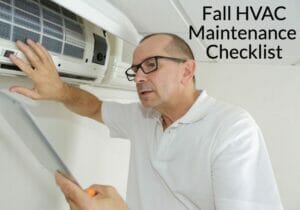HVAC Inspection Checklist for Residential Homeowners
Before the cooler temperatures close in, it’s important to ensure your HVAC system is in great shape and ready to take you through those winter months.
There’s a lot you can do as a homeowner to support the healthy operation of your HVAC system between visits from your friendly neighbourhood HVAC service technicians. Here’s a Fall HVAC Maintenance Checklist with tips for DIYers and guidelines on when to call Lockhart Industries for help.
HVAC Filters
Where there is airflow, dust and debris can accumulate. It’s no different with your HVAC system. When dirt builds up in your air filters, airflow can become compromised and place strain on the parts and mechanisms of your HVAC system. Unchecked, this can lead to extensive damage and even more costly repairs. Unobstructed airflow is key to ensuring optimal functioning of your HVAC system, and one of the best ways to support healthy air flow.
- Replace your air filters regularly
- Check your air filters every 30-90 days
- Vacuum away dust and debris on lightly soiled air filters
Keep the Outdoor Unit on Your HVAC Clear
If your HVAC system has an outdoor unit, you’ll want to prioritize clearing the unit and the surrounding area of any debris on a regular basis – we recommend a weekly check. In the spring and summer, fast-growing landscaping, grass clippings and even pollen are common culprits. In the fall and winter, it’s fallen leaves and ice or snow build-up. Materials left to collect can cause erosion of the coils, which can then result in refrigerant leaks.
It’s always a good idea to use gloves when attending to your outdoor unit. For your own safety, Lockhart Industries recommends that you shut down your HVAC system before clearing around it.
- Clear the HVAC unit and surrounding area of any debris every week
- Weed whack and mow around the unit to keep it clear
- After storms or windy periods, check the surrounding area for fallen leaves and branches
- Clear any ice or snow buildup from around the HVAC unit
- Use a good quality cleaning spray to loosen any deposits that may have hardened onto the coils.
- Check outlets and wiring for any damage
Check AC Drain Pipe
Fall is also a good time to check for build up in the A/C drain pipe. If there is a blockage, trapped condensation can freeze over winter and can back up into your home when you fire up the A/C next summer. Symptoms of a clogged A/C condensate drain pipe include a moldy or musty odour near your indoor unit or around the vents in your home, standing water or water damage near the indoor unit or the system just won’t turn on and isn’t working properly.
- Turn off the HVAC unit
- Check the drain pan for standing water. If it’s wet, clean the drain pan to get rid of any mold that may be forming
- Check for blockages in the A/C drain pipe, usually caused by dead vegetation, dirt and even insects
- Use your garden hose, shop vac, or a large plumbing snake to flush out the clog in the drain pipe. This will be similar to unclogging a vacuum hose or a household sink
- Once the clog is removed, pour a cup of distilled vinegar through the drain pipe
- Turn the system back on and watch for any signs of a continuing clog
- If there is still a clog, be sure to call a professional HVAC company.
Indoor HVAC Vents
We already know that air flow is key to maintaining an operational HVAC system and, you guessed it, that includes your vents too! Just like your air filters and the outdoor unit, your vents (or registers as they are sometimes called) can collect all manner of dust, pet hair and other debris.
- Regularly clean dust, pet hair, kids’ toys, socks and other debris from vents and registers.
- If furniture is covering vents, move it over and inspect the vent covers and interior of the vents.
- Unscrew the vent cover (if applicable) and remove. Use a brush attachment to vacuum out the vent opening.
- Use a gentle cleaning solution (soap and water will do just fine) to scrub any sticky dust or residue.
HVAC Humidifier
If your HVAC system features a humidity setting, the cooler months are a great opportunity to give your humidifier a little TLC after a hard summer’s work.
- Turn off the HVAC humidifier’s water supply
- Change out the humidifier pad (sometimes called the water panel)
- Reset the relative humidity between 35 and 45%
- Turn the water supply back on
HVAC Refrigerant Charge
Earlier in the article we explained how corroded coils caused by debris build-up can lead to refrigerant leakages. But how do you know if there is a leak? With many HVAC systems, you can actually check the refrigerant charge. If the reading is low, that means there’s a leak and the sooner you fix it, the better.
Listen to Your HVAC
You’re driving along the road and suddenly your car starts making strange noises, so you begin troubleshooting… Does it need an oil change? Is the coolant low? Maybe the tire pressure needs attention. Or maybe it’s just something rattling around in the back seat. Sound familiar? Treat your HVAC system like you would your car – if you hear an unusual noise, start troubleshooting. Maybe there’s an airflow blockage or a loose item rattling around in a vent. Most of the time you’ll be able to find the source of the noise with a bit of careful listening, but if all else fails….
Get Help From The Heating & Cooling Professionals at Lockhart Industries
This simple DIY checklist can help you maintain your HVAC system throughout most of the year and save you from unnecessary and costly repairs. Preventative maintenance is key! But there are some things that are always best left to the certified HVAC professionals, particularly when it comes to parts, repairs and even more complex system maintenance.
If your main source of heat is a gas furnace, it should always be professionally inspected, cleaned and adjusted each season. Certified HVAC Technicians will check your gas lines and ensure that your furnace flue is clear.
We also recommend periodic ductwork inspections as part of your fall maintenance plan. Tightly sealed ducting is important to ensure optimal energy efficiency, particularly during the colder months. By contrast, leaky ducting can not only impact your home’s air quality but, in the case of gas systems, can also draw exhaust fumes and carbon monoxide into the air.
If you’d like to book an HVAC servicing, please contact us at 250-748-1731 and our service technicians will book a time that’s convenient for you to have your HVAC serviced. Victoria to Duncan BC, we’re your one-stop heating and cooling shop.
Easy Financing with…
Start Saving Money NOW! There’s no need to putting off a more Energy Efficient, Cost Effective home comfort system. We make it simple!
With Financeit you can:
- Make additional payments any time without penalty.
- Get a lower payment by choosing an amortization period of up to 180 months. 7.99% to 11.99% interest rate.*
- We add a small fee to the loan amount. There are no hidden or additional charges
- Bank-level encryption (AES-256 bit SSL) to protect your personal information.



